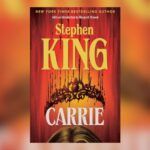
Queer Superhero History: Northstar
In recent years, mainstream comics publishers like DC and Marvel have made great strides in increasing the LGBTQ+ rep in their universes, though they still have a long way to go. But getting here was a slow and gradual process, with many notable landmarks — and some admitted missteps — along the way. In Queer Superhero History, we’ll look at queer characters in mainstream superhero comics, in (roughly) chronological order, to see how the landscape of LGBTQ+ rep in the genre has changed over time. Today, at long last: Northstar!
Content warning: discussion of fictional and real world homophobia, sexual assault, implied statutory rape, and AIDS.
Northstar is often called the first gay superhero, although he wasn’t allowed to come out until 13 years after his debut. But he was almost certainly the first mainstream superhero deliberately (albeit subtextually) depicted as queer, he was Marvel’s first gay superhero, and his coming out in 1992 was a landmark event, as was his eventual wedding to his husband, Kyle, 20 years later.
I will begin with this disclaimer: I am not going to do justice to this subject in the space I have here. Scholarly papers have been written about Northstar’s history and significance; there are decades of blog posts, letter columns, zines, and newspaper articles, not to mention the comics themselves. This profile could very well be a book — and I hope someone writes it someday so I can read it. But in the meantime, here’s the condensed version:
Jean-Paul Beaubier, AKA Northstar, was created by Chris Claremont and John Byrne, and he first appeared in X-Men #120 (April 1979) as a member of the Canadian superhero team Alpha Flight, along with his twin sister Jeanne-Marie Beaubier (Aurora). He didn’t really get a personality beyond “French-Canadian” until Alpha Flight got their own book in 1983, which was initially both written and drawn by Byrne.
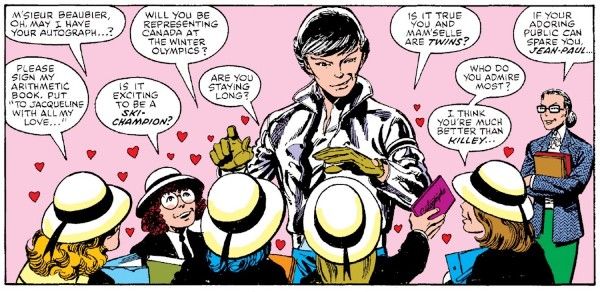
Byrne has always been very upfront that when he began fleshing out the personalities of the members of Alpha Flight, he wanted one of them to be gay. As early as 1988, after Byrne had left Marvel and created Maggie Sawyer for DC and before the Comics Code Authority lifted the rule against queer characters, Byrne flatly told the magazine Amazing Heroes: “I created the first gay super-hero,” meaning Northstar.
In a post on his personal website from 2004, now saved as a Frequently Asked Question, he explains how he chose Jean-Paul: “and the moment I did I realized it was already there. Somewhere in the back of my mind I must have been considering making him Gay before I ‘decided’ to do so. Of course, the temper of the times, the Powers That Were and, naturally, the Comics Code would not let me come right out and state that Jean-Paul was homosexual, but I managed to ‘get the word out’ even with those barriers.”
Byrne doesn’t name those “Powers That Were,” but it’s worth noting that Marvel lagged behind DC when it came to queer representation. DC’s first out gay superhero, Extraño, appeared before the CCA permitted queer characters; they had Maggie Sawyer and Pied Piper and numerous LGBTQ+ characters in Sandman.
Marvel, meanwhile, had Jim Shooter. Shooter was editor-in-chief from 1978-1987, and is widely believed to be responsible for an alleged “no gays in the Marvel universe” policy during that time. I can’t find a firm source on that, though respected comics historian Alan Kistler says that Byrne claims Shooter told him directly that Northstar could not be gay. What is undeniable fact, however, is that Shooter actually wrote the very first gay characters in the Marvel universe in an infamous Hulk story from 1980 called “A Very Personal Hell,” in which Bruce Banner is nearly raped by two men in the showers at the YMCA. Yes, really. If that’s emblematic of his views on gay people, it’s not hard to believe he would have forbidden a gay superhero.
And so Byrne was left with subtext. Here’s a non-exhaustive list of some of the winks and nods he and subsequent writers snuck in over the next few years:
- #7: We meet Raymonde Belmonde, a man who took Jean-Paul in as a teenage runaway, with the uncomfortable implication that they were lovers despite Jean-Paul’s age. Belmonde is described as: “More than a father, much more than a friend, he had found Jean-Paul, scarcely more than a boy, alone and frightened. Frightened of what he thought he was, and what he feared he might become…his mutant powers, or any other thing.” (Italics mine.)
- #10: A teammate mentions that Jean-Paul’s success as a professional skier brought him “money, fame, women…although the women don’t seem to have interested you overmuch.”
- #29: Aurora’s boyfriend Sasquatch (yes, Sasquatch) dies. She sees Jean-Paul weeping and says “You too!” with the implication that Jean-Paul was also in love with him (yes, Sasquatch). Aurora even later refers to Sasquatch as “our beloved” when speaking to Jean-Paul.
- #36: Jean-Paul dismisses the notion of getting a woman pregnant with “C’est impossible!”
- #41: Aurora says “Since when do you object to having attractively-dressed men about, my brother?”
- #42: In a particularly tasteless moment, after having been mind controlled by a female character with a crush on him into serving her, Jean-Paul says “I felt violated — as if I’d been raped!” to which a teammate retorts: “And by a woman! No wonder you’re so upset!”
- #46: Sasquatch returns to life with a female body (comics! it’s…not well handled) and Jean-Paul tells him that like Aurora, he prefers Sasquatch as a man.
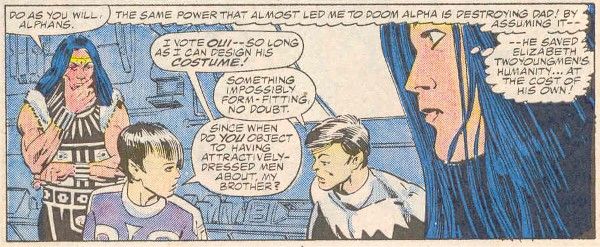
Bill Mantlo took over as the regular series writer with #29, and eventually decided to tackle the inevitable AIDs plotline. As he told The Advocate that year: “It would give me the opportunity to deal with a frightening, sad, controversial topic in a comic book — which I had always understood Marvel was about.”
I’m of two minds about this. As I’ve mentioned in my profiles on Extraño and Pied Piper, AIDS storylines were essentially mandatory for gay male characters during this era, and read as exhaustingly stereotypical now, especially since Mantlo planned to have Northstar die — a likely outcome of testing positive back then, but still an example of the “bury your gays” trope. On the other hand, Mantlo started this story in 1987, when AIDS was new, terrifying, and highly controversial; AZT was first approved in 1987, and Reagan had only publicly acknowledged the epidemic the year before. Thoughtful, responsible stories about AIDS were necessary, and it seems like that’s what Mantlo wanted to write.
He never got the chance. The book’s editor, Carl Potts, objected to the notion of outing Northstar only for the purposes of killing him — a reasonable concern — while Shooter seems to have objected to the notion of outing Northstar, period. As Mantlo put it, “An edict came down declaring that not only could Northstar not die of AIDS, but we couldn’t even have a gay character because it was too controversial!”
Either way, the story had already begun, which meant that an unhappy Mantlo had to change his plans mid-stream. So in #42, Jean-Paul gets sick, with a lingering cough and a wound that refuses to heal. His symptoms worsen, especially after he’s kissed (on the forehead) by a villain named Pestilence, who claims this will accelerate “the slow disease spreading like a cancer through your cells!” Any reader in 1987 would have understood where this was going.
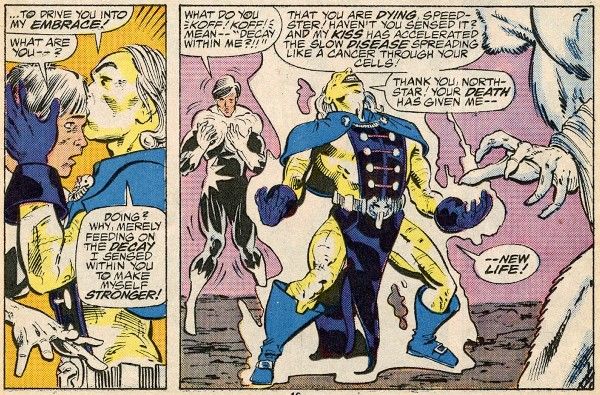
And then in #50, it’s abruptly revealed that Jean-Paul and Jeanne-Marie’s mother was an elf, and Jean-Paul is dying because he needs to return to Alfheim, the Nordic land of the elves. The would-be AIDS storyline became instead a story about, well. A fairy dying of a fairy disease, literally. (This was also later retconned to be a trick of Loki’s; Northstar and Aurora are mutants, as they always believed, not elves.) To add insult to injury, Northstar was then promptly written out of the book for several years. It’s levels upon levels of erasure.
His return eventually brings us to the landmark Alpha Flight #106, written by Scott Lobdell, drawn by Mark Pacella, and edited by Bobbie Chase. Fun fact: the assistant editor on the book was Chris Cooper, one of Marvel’s first openly gay staffers, though in an interview in Marvel Voices: Pride 2021, he credits the idea of finally letting Northstar come out to Lobdell. The story begins with Jean-Paul finding a baby in a garbage can, which, uhhh…doesn’t bode well, let’s say.
Jean-Paul promptly adopts the baby, only to learn that she is HIV-positive. (I told you AIDS storylines were inevitable. This one is…less sensitive than I suspect Mantlo’s would have been.) The media picks up the story, sparking an outpouring of sympathy for the baby — and infuriating an obscure retired superhero named Major Mapleleaf, created specifically for this issue, who bursts through the wall of the hospital like the Kool-Aid man to kill the baby. Jean-Paul defends her, and as they smash their way across the city, Mapleleaf screams that his son also died of AIDS, but because he was gay, no one cared. Why this means the baby has to die is not really explained.
“Do not presume to lecture me on the hardships homosexuals must bear. No one knows them better than I,” Jean-Paul says, fists swinging. “For while I am not inclined to discuss my sexuality with people for whom it is none of their business – I am gay!”
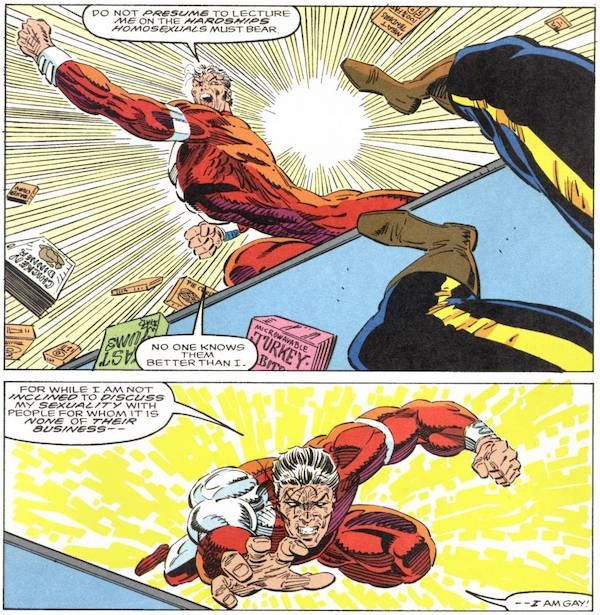
And there it was. Finally. 13 years after his debut, nine after John Byrne started deliberately coding him as gay, Jean-Paul Beaubier was allowed to come out.
The bizarre, stilted argument continues as the superheroes whale on each other, with Jean-Paul pointing out that AIDS isn’t just a gay disease and Mapleleaf claiming that by staying closeted, the famous superhero/athlete Jean-Paul is somehow directly to blame for Mapleleaf Jr’s death. Then they hug. Then the baby dies. Then Jean-Paul holds a press conference in which he comes out.
Yeah.
I’m going to be honest with you: this is a terrible comic book. The ludicrous “ripped from the tabloids” garbage can baby instantly undermines any attempt at seriousness. Jean-Paul screaming “I am gay!” in the middle of an over-the-top fight does likewise, and the dialogue about homophobia and AIDS stigma sounds like the characters are reading it off of cue cards while filming a PSA. The art is the very worst the XTREEM trend of the ’90s has to offer, with distorted anatomy and everyone grimacing through every panel. There is a character named Major Mapleleaf.
And yet Alpha Flight #106 sold out in a week, and the story made it into the mainstream press, covered by places like The New York Times. It may not have been a good comic, but it was still a big deal.
Big deal or not, though, Northstar’s sexuality was barely mentioned throughout the rest of the series, which was canceled a couple years later. He starred in his own four-issue miniseries in 1994, and rejoined the X-Men in 2002, where he developed an unrequited crush on Iceman (who of course, is now also canonically gay). In 2005, three different versions of Northstar were killed off within the space of a month, including the main 616 universe. The 616 version returned in the very next issue, but it was still an impressively awful bury your gays hat trick, and fans were not impressed.
In 2009, he began dating civilian Kyle Jinadu, and in 2012, Northstar once again grabbed national headlines when he and Kyle got married in Astonishing X-Men #51, the first same-sex wedding in mainstream superhero comics. They are still together.
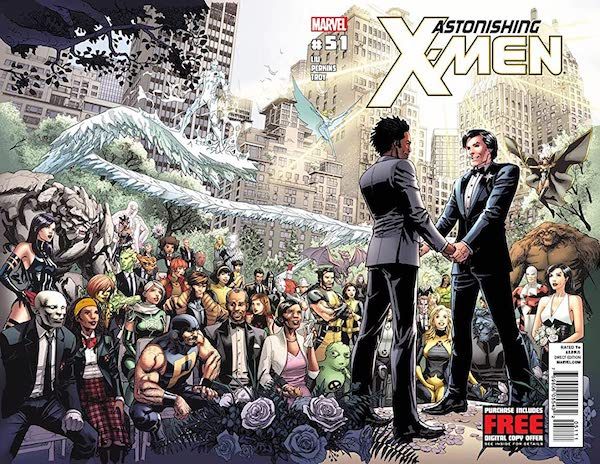
Northstar holds the awkward position of being an incredibly important character without actually being a major Marvel star. As such, he’s often a placeholder for straight writers’ ideas about gay men, such as the implied underage sexual relationships with older men in his past, or the multiple AIDS storylines. His personality and relationships shift to reflect (usually well-meaning) stereotypes: Now he’s haughty and aloof! Now he’s tragic! Now he’s sassy! Now he’s every straight woman’s best friend!
At the same time, his prominence means his stories are invaluable, flawed as they often are. Northstar matters. He mattered to queer fans who read between the lines in the ’80s, and he matters to everyone who bought his wedding issue a decade ago.
Northstar no longer has to carry the weight of all the queer representation in the Marvel universe, thankfully: there are dozens of LGBTQ+ characters now, many of them fan favorites. But Northstar paved the way, thanks to the creators and fans who fought for years for him to come out, and that’s something to be grateful for. Merci beaucoup, Monsieur Beaubier.



